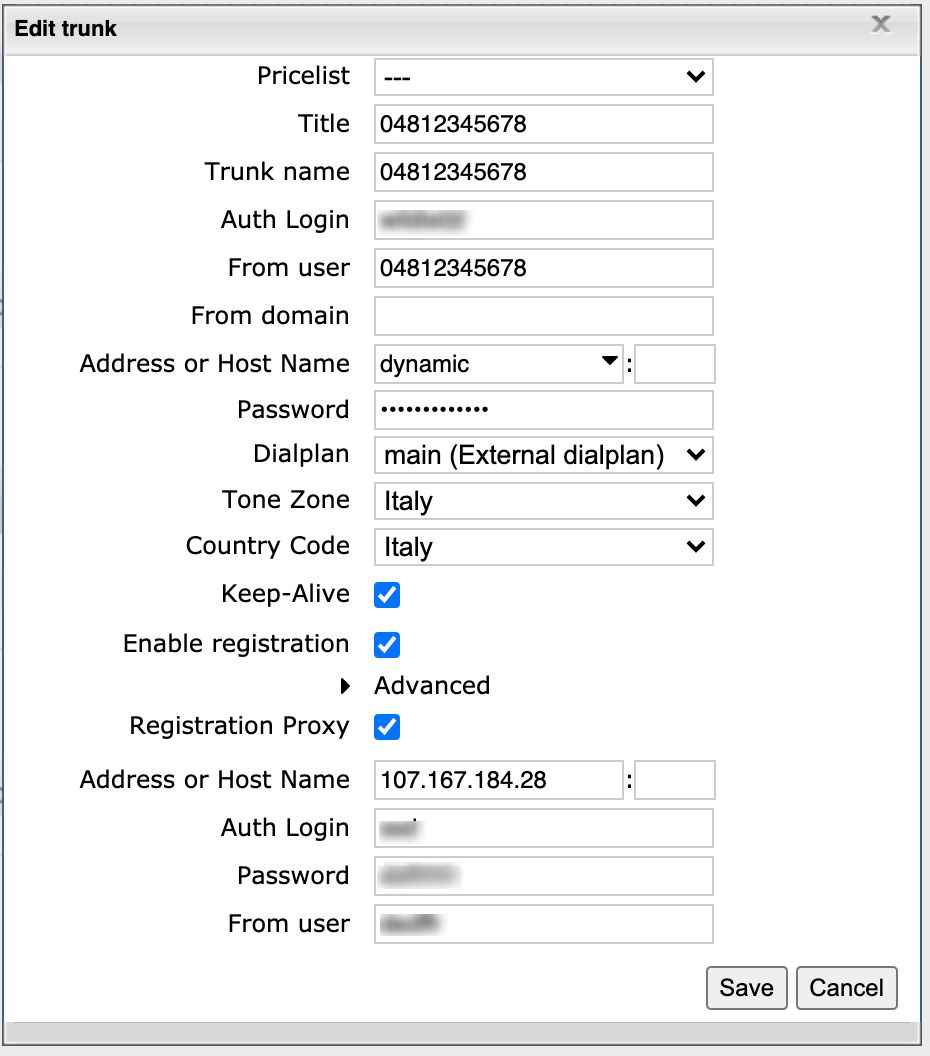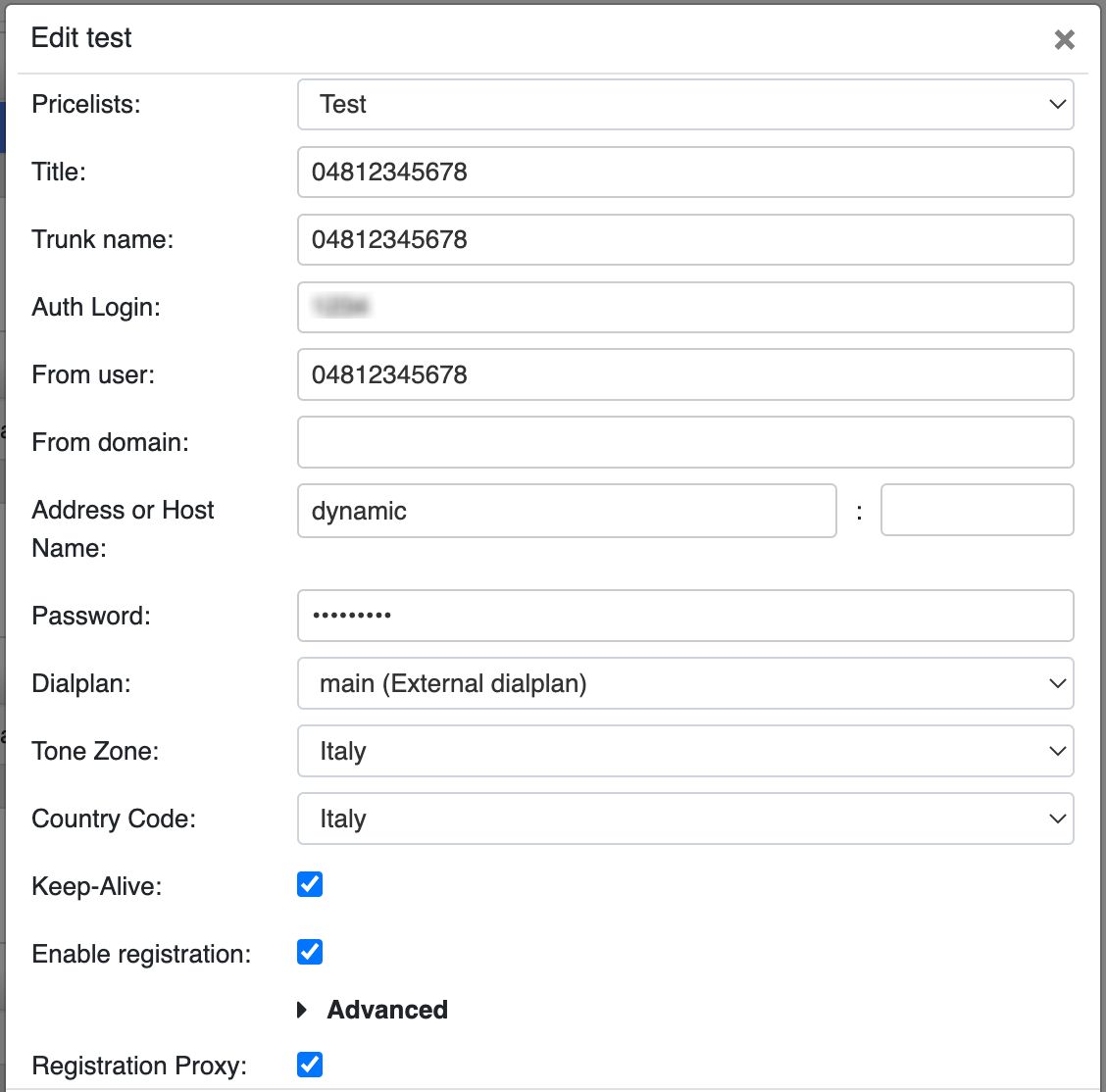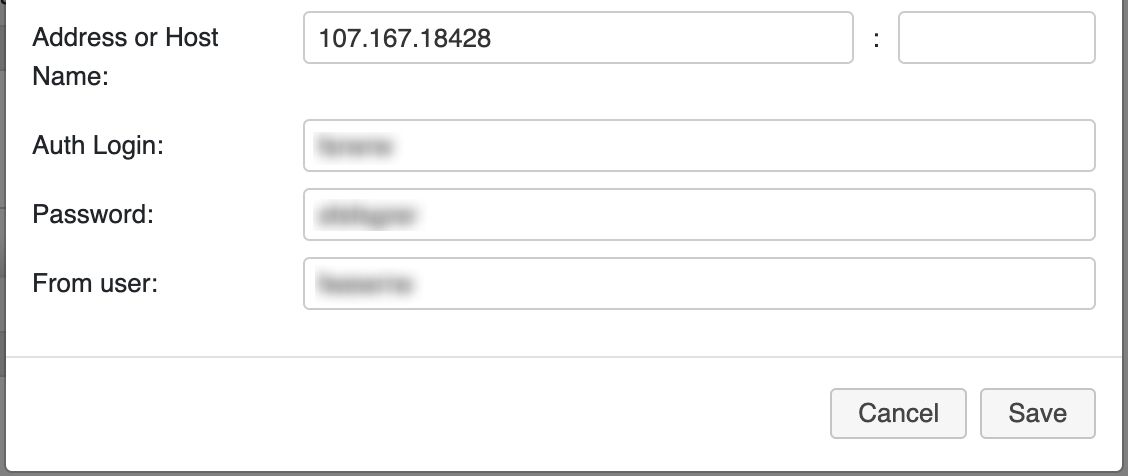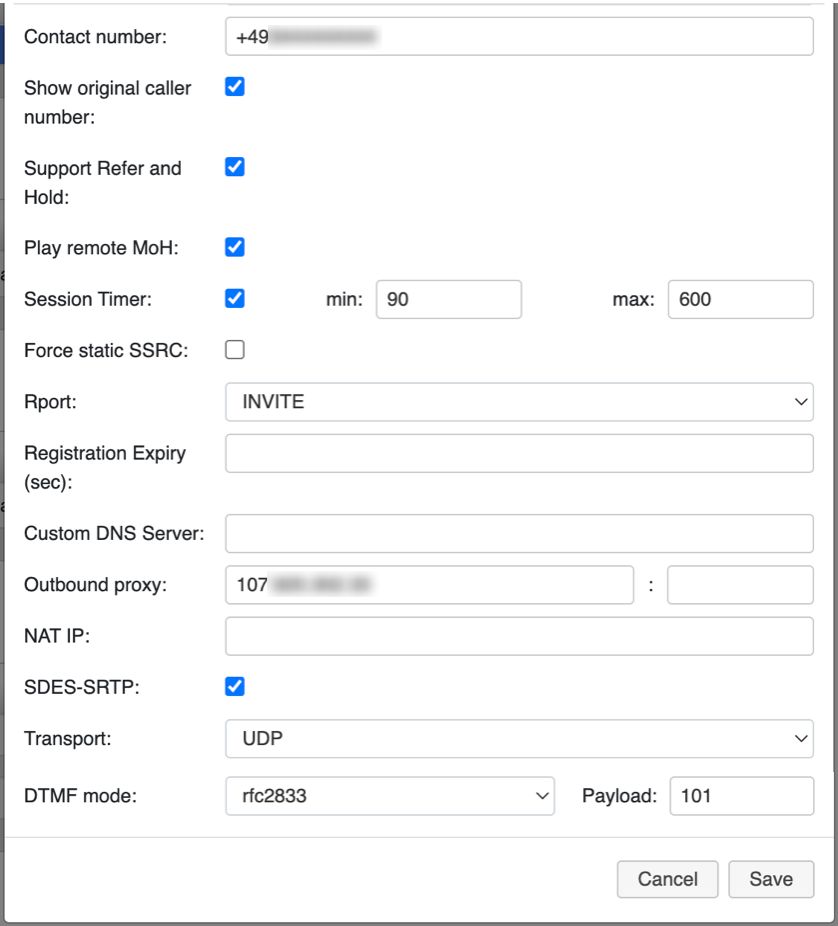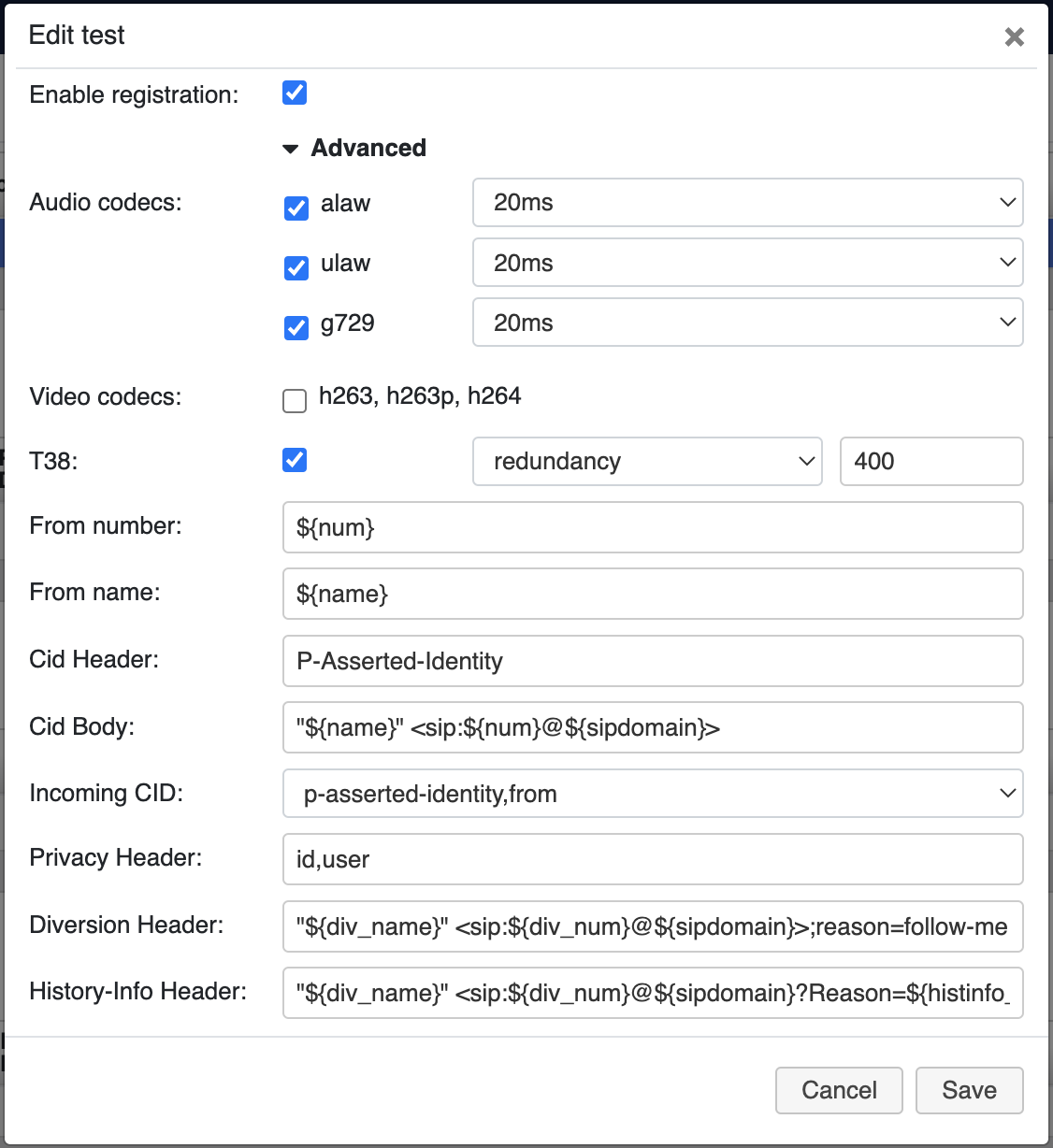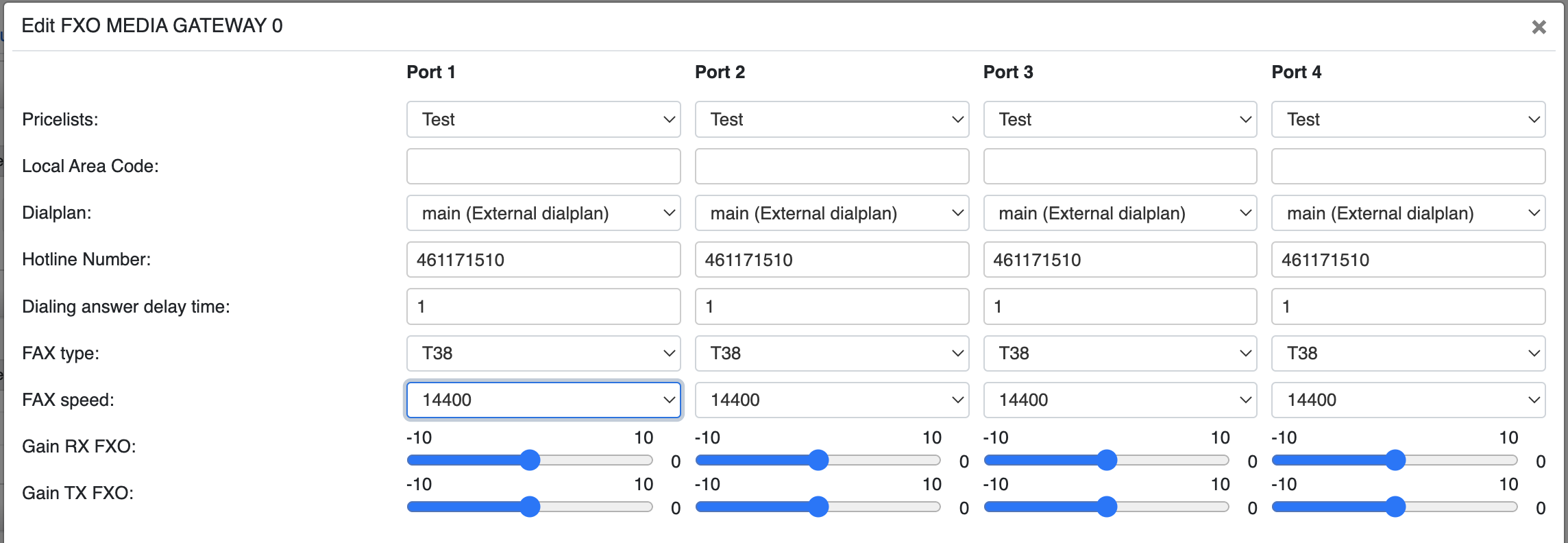| Scroll export button | ||||||||
|---|---|---|---|---|---|---|---|---|
|
| Info |
|---|
The following Admin Guide describes Trunk Settings and explains how to set up various parameters. Updated: December 2022 WMS version: WMS 6.0X / WMS 5.0X Permalink: https://wildix.atlassian.net/wiki/x/tx7OAQ |
| Note |
|---|
BRI/ PRI Media Gateways are EOL. |
...
- Pricelist: associated pricelist for the correct calculation of calls cost (must be configured in WMS -> Trunks -> Pricelists)
- Title: description of the trunk
- Trunk name: trunk name
- Auth Login: provided by the VoIP Carrier for authentication
- From user: forced from number header and used for invite messages and for registration (if From domain is not empty), usually the same as Auth login
- From domain: forced from domain header and used in register and invite SIP messages
- Address or Host Name: address or host name of sip proxy; dynamic indicates that the trunk is used for incoming registration (incoming invites are allowed)
- Password: password for authentication provided by the VoIP Carrier
- Dialplan: Dialplan procedure for routing calls coming from this trunk (usually, “main”)
- Tone Zone: select the country/ region
- Country Code: used for number normalization, specify the code of the country where the trunk is used
- Keep-Alive: enable periodic sending of keep alive messages to the trunk
Enable registration: enable outgoing registration (in case of PBXs SIP interconnection, it is enabled on the Client PBX SIP trunk and disabled on Server)
- Registration proxy (appears after checking off Enable registration, optional): enter IP address or host name of a proxy server with the port (the default port is 5060) and credentials for access
- Advanced
- Audio codecs: enable the audio codecs supported by the trunk and the ptime values: 20ms – 40ms – 60ms (20ms by default); in case a different priority is needed, use “Set” -> “Codec” Dialplan application
- Video codecs: enable the video codecs supported by the trunk
- T38: special parameters for T38 support and the maxdatagram
- From number: add an expression to set a dynamic cid number for outgoing calls based on the office number or on the value “Set” -> “cid number” on trunk Dialplan application; works only if the operator allows setting of a cid number for outgoing calls
- From name: add a regular expression to set a dynamic cid name for outgoing calls
- Cid Header: add an additional header to set the cid number
- Cid Body: indicate the contents of the cid header
- Incoming CID: setting of a specific SIP header from which Cid header must be retrieved. Available options: p-asserted-identity,from (default) / from
- Privacy Header: setting of the privacy header content supported by the operator to perform anonymous calls via feature code “Hide number” (92 by default)
- Diversion / History-Info Header: add SIP header Diversion and History-info for outgoing INVITE to trunk in order to preserve the information on the original called number in case of call forwarding
- Contact number: allows to set custom contact number in SIP trunk configuration; Note: The field is available starting from WMS v. 6.01.20221019.4
- Show original caller number: can be used by operators which support displaying any number as cid, allows displaying original caller number from trunk in case of transfers/ mobility calls
- Support Refer and Hold: allow the trunk to perform transfers and disable hold requests from the trunk
Play remote MoH: configure remote music on hold to be played instead of the local one for external calls
Warning Limitation: For the Play remote MoH settings to apply, make sure the Support Refer and Hold option is enabled.
- Session Timer: enable the check of the session validity to avoid pending calls; if enabled, the value 360secs is used, if disabled – 7200 secs
- Force static SSRC: forbid SSRC change in RTP sessions; this option is recommended for some SIP operators which do not playback RTP packets after change of SSRC
Rport: the rport mechanism changes the SIP routing behavior, so that responses can be received through a NAT even if private addresses are used in the SIP headers; available options: INVITE (default), REGISTER/INVITE, off
Warning Limitation: If PBX is behind NAT and uses trunk with rport REGISTER, INVITE, the remote side may drop calls after 30 seconds.
- Registration Expiry (sec): set the expiry time for outgoing register messages (default=600 sec / min=0)
- Custom DNS Server: used to resolve the sip proxy domain name
- Outbound proxy: all outgoing SIP messages are sent through the indicated host
- NAT IP: enable the network connection IP
- 100rel: enable reliable transmission of provisional messages
- SDES-SRTP: enable SDES-SRTP protocol for calls through the trunk
- Transport: select the transport protocol to be used: UDP/ TCP/ TLS/ auto (dns ptr-srv)
- DTMF mode: allows you to select the DTMF transfer mode: info/ rfc2833/ inband and specify the payload
Supported VoIP operators and examples of configuration
...
- Tone Zone: select the country/ region
- Country Code: used for number normalization. In case “Custom country” is selected, you can manually enter the country code
- Impedance: select one of the impedance values to avoid noise during line connection
- DC Impedance (disabled by default)
- Obtain FSK CID from (available for W04FXO 2020): select the value to display the correct Caller ID. The default value depends on a language selected in WMS Settings -> PBX -> Language&Region:
- for English-US, the default value is Callee
- for other languages, the default value is Nu
- Pricelist: the pricelist to calculate the costs for calls through the trunk
- Local Area Code: specify the area code
- Dialplan: Dialplan procedure for routing calls coming from this trunk (usually, “main”)
- Hotline Number: the number corresponding to the line which is present in the associated Dialplan procedure
- Detect caller ID (available for FXO gateways pre 2020): enable/disable caller ID detection
- Caller ID type (available for FXO gateways pre 2020): select the standard for transmitting the caller ID information
- Flash time (available for FXO gateways pre 2020): timeout (in msec) for hookflash detection
- Dialing answer delay time: interdigit dial timeout (in sec), when terminated, the call is sent to trunk (the value cannot be less than “1”)
- FAX type: select the mode (T38 or Bypass)
- Gain RX FXO: adjust incoming audio gain
- Gain TX FXO: adjust outgoing audio gain
- Disconnect signaling: select one of the options:
- Busy tone (the default value)
- Polarity reversal: enable/ disable this parameter to avoid dropped calls due to a wrong detection of polarity change on the copper line
- Open switching interval: enable/disable the parameter and set the Current Disconnect Threshold in ms
- Polarity reversal on answer: enable/ disable this parameter as the cause for disconnecting the call
- Silence detection: enable/ disable this parameter as the cause for disconnecting the call and specify the timeout in second
...
| Note |
|---|
These parameters are available for W04FXO R3 starting from WMS 5.03. |
| Note |
|---|
FXO gateway can be used to connect an Analog PBX to Wildix VoIP PBX or to enhance some users with Unified Communications features such as fax server, mobility, IVR, timetables etc. Read the White Paper: https://drive.google.com/drive/u/0/folders/10kpqi9yJM6gZ7E_YhkmHX6g0pSOTL0KB |
...
